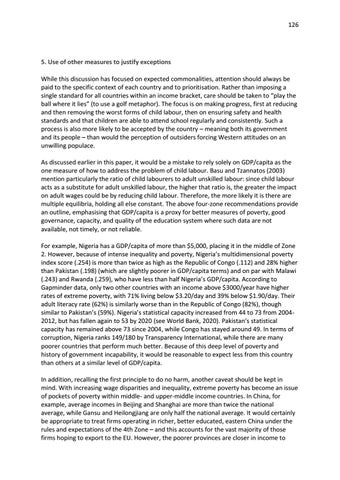126
5. Use of other measures to justify exceptions While this discussion has focused on expected commonalities, attention should always be paid to the specific context of each country and to prioritisation. Rather than imposing a single standard for all countries within an income bracket, care should be taken to “play the ball where it lies” (to use a golf metaphor). The focus is on making progress, first at reducing and then removing the worst forms of child labour, then on ensuring safety and health standards and that children are able to attend school regularly and consistently. Such a process is also more likely to be accepted by the country – meaning both its government and its people – than would the perception of outsiders forcing Western attitudes on an unwilling populace. As discussed earlier in this paper, it would be a mistake to rely solely on GDP/capita as the one measure of how to address the problem of child labour. Basu and Tzannatos (2003) mention particularly the ratio of child labourers to adult unskilled labour: since child labour acts as a substitute for adult unskilled labour, the higher that ratio is, the greater the impact on adult wages could be by reducing child labour. Therefore, the more likely it is there are multiple equilibria, holding all else constant. The above four-zone recommendations provide an outline, emphasising that GDP/capita is a proxy for better measures of poverty, good governance, capacity, and quality of the education system where such data are not available, not timely, or not reliable. For example, Nigeria has a GDP/capita of more than $5,000, placing it in the middle of Zone 2. However, because of intense inequality and poverty, Nigeria’s multidimensional poverty index score (.254) is more than twice as high as the Republic of Congo (.112) and 28% higher than Pakistan (.198) (which are slightly poorer in GDP/capita terms) and on par with Malawi (.243) and Rwanda (.259), who have less than half Nigeria’s GDP/capita. According to Gapminder data, only two other countries with an income above $3000/year have higher rates of extreme poverty, with 71% living below $3.20/day and 39% below $1.90/day. Their adult literacy rate (62%) is similarly worse than in the Republic of Congo (82%), though similar to Pakistan’s (59%). Nigeria’s statistical capacity increased from 44 to 73 from 20042012, but has fallen again to 53 by 2020 (see World Bank, 2020). Pakistan’s statistical capacity has remained above 73 since 2004, while Congo has stayed around 49. In terms of corruption, Nigeria ranks 149/180 by Transparency International, while there are many poorer countries that perform much better. Because of this deep level of poverty and history of government incapability, it would be reasonable to expect less from this country than others at a similar level of GDP/capita. In addition, recalling the first principle to do no harm, another caveat should be kept in mind. With increasing wage disparities and inequality, extreme poverty has become an issue of pockets of poverty within middle- and upper-middle income countries. In China, for example, average incomes in Beijing and Shanghai are more than twice the national average, while Gansu and Heilongjiang are only half the national average. It would certainly be appropriate to treat firms operating in richer, better educated, eastern China under the rules and expectations of the 4th Zone – and this accounts for the vast majority of those firms hoping to export to the EU. However, the poorer provinces are closer in income to













